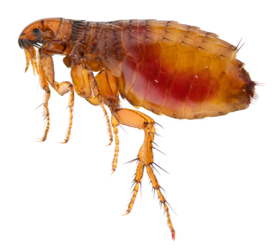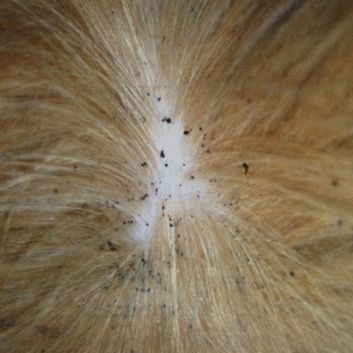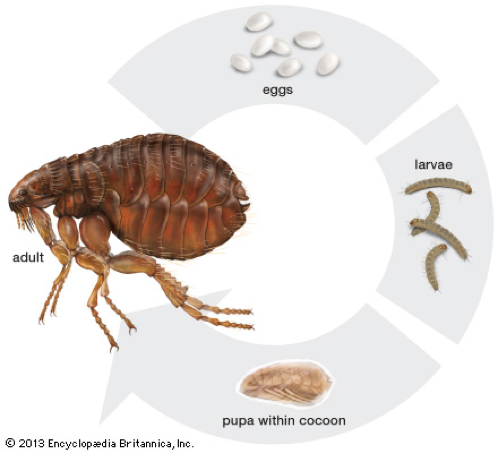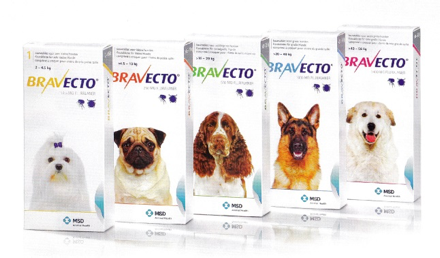There are over 1900 species of fleas. The species that we are most concerned about with our pets, found in 99% of cases, is called Ctenocephalides felis. This flea is not specific to cats, as the “felis” name may suggest, but will also affect dogs, rabbits, and multiple other species. While some people may consider themselves a target for flea bites as well, this species of flea doesn’t generally prefer human blood and we don’t tend to get bitten unless the population of fleas is high in the home.

Many people think if their animals do not go outside, they have no risk of getting fleas. In reality, fleas can enter our homes on our clothing or on other animals that may come in and out of the house and this puts all pets at potential risk. It isn’t difficult for fleas to climb onto us in the outdoors or, for example, if you were to visit a friends house with outdoor pets and an active flea infestation. They are so small that they would more than likely go unnoticed until you had your own infestation.
Once inside your home, fleas can develop in the carpet or in the cracks between the boards of hardwood floors. Female fleas can lay up to 2000 eggs in their short lifetime, so it doesn’t take long to have a large infestation in the home. The easiest way to check for fleas, other than seeing them on the animal or jumping around your home, is to look for flea dirt on your pet with a flea comb. Dirt on your pet can be confirmed to be from fleas instead of just regular everyday dirt by placing it on a paper towel and wetting it. Flea dirt will turn red because it is the digested blood from the fleas meals.

To fully understand how to treat a flea infestation in your home, it is helpful to have a basic understanding of the flea life cycle. There are four different stages of fleas: the egg, the larva, the pupa and the adult. The troublemakers of the group are the pupae, who are spun in cocoons and are impossible to kill. They can stay dormant in this stage for many months waiting for the right time to emerge. This is why it is very important to treat for fleas year round. If you don’t, you could end up with a whole new infestation in your home a few months later once the pupae start hatching.

While a flea infestation can be a great nuisance for both pet and owner, fleas pose a greater potential threat to our pets than we may realize. Heavy infestations can sometimes cause so much harm to the animal that it can be fatal, especially in smaller or younger pets. Fleas can cause a variety of conditions, including flea allergy dermatitis (an allergy to the flea saliva causing extreme itchiness, the most common issue), flea anemia (a decrease in red blood cells caused by the frequent feeding of heavy infestations), feline infectious anemia (a life threatening blood parasite carried by some fleas), or even tapeworms if a flea carrying their eggs gets eaten.
Treating for fleas used to be based on shampoos, powders, collars, sprays and other similar products. Many of these are still available today, however have been largely replaced by newer, safer, vet-recommended and more effective products. Common flea products you have likely heard of include monthly topical treatments, such as Revolution and Advantage, and newest on the market, Bravecto, an oral flavored chew that lasts for three months. Every product has it’s pros and cons, so it is important to discuss with your veterinarian which product fits best with your dog’s lifestyle. DO NOT use any over the counter flea medications, such as Hartz brand, because the pesticide used in these medications can be extremely dangerous and sometimes fatal to our pets, especially in cats.
Examples of popular vet-recommended flea treatments: Revolution and Bravecto
When it comes to treating the home, you can buy sprays that are meant for killing fleas in the environment. Make sure to remove your pets from the area being sprayed and spray in all corners of the room and all around the baseboards, as this is where the flea eggs and larvae are most concentrated. Wash all bedding (fleas won’t survive a run in the dryer!) and vacuum the floors as well, but be sure to discard the vacuum bag afterwards to prevent eggs hatching inside the vacuum.
As previously mentioned, the best prevention occurs when all pets in the home are treated year round. Keeping this in mind, the most crucial time of year for fleas usually begins in March/April and ends in October/November, depending on the weather. This year, our winter was quite mild, so flea and tick season started earlier than normal. If you haven’t started treating for pets for 2016 flea and tick season, you should start now!
If you have any questions about fleas that wasn’t covered here or would like to discuss your options for flea treatment and prevention, please contact your veterinarian. Call 506-388-8880 to book an appointment here at VetCare Pet Hospital! 🙂
Written by Stephanie






